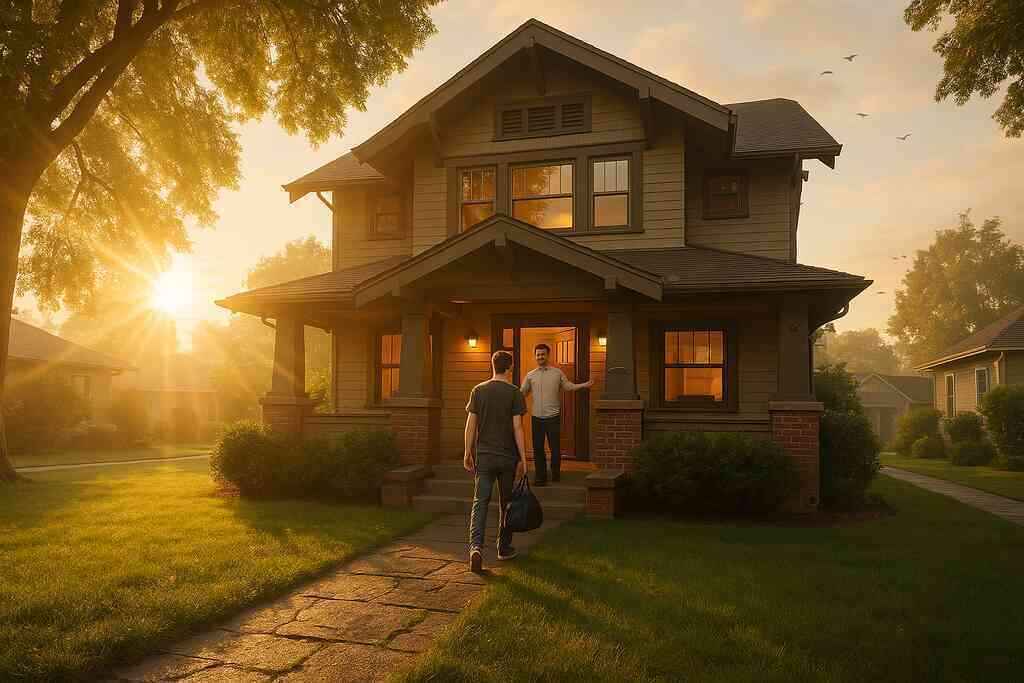
Exploring Safe Living Environments in Top Sober Home
July 15, 2025
Illuminating the Path to Recovery
Understanding the Foundation of a Recovery-Focused Community
The journey toward sobriety is best navigated within the confines of a recovery-focused community. These communities provide a structured recovery environment where individuals can thrive in their pursuit of an addiction-free lifestyle. Within recovery-focused communities, individuals find a robust support network that aids in maintaining long-term sobriety. These environments are designed as substance-free sanctuaries, offering a haven for those in early recovery. By fostering peer support and providing safe sober housing, such communities lay the groundwork for a healthy, alcohol-free lifestyle.
Importance of a Supportive Home Atmosphere for Sobriety
A supportive home atmosphere is crucial for individuals in early recovery looking to cultivate a sobriety-centric lifestyle. This atmosphere is a pivotal component in reinforcing an individual’s commitment to sobriety. Supportive home atmospheres in Connecticut encourage positive behavioral changes and provide reinforcement through structured living environments. Residents are guided by house managers, who ensure that everyone stays on the path to long-term sobriety while providing reintegration support. The presence of a nurturing environment is essential as it significantly reduces the chances of relapse, facilitating a smoother transition into an alcohol-free living environment.
Guided Search: Finding the Right Sober Living Environment
Finding the ideal sober living environment is a critical step in the recovery journey. The process is made more accessible through a guided sober living search, utilizing resources like Top Sober House directories. These tools simplify the daunting task of locating a recovery-focused community that meets individuals’ specific needs. A structured search ensures you’ll find the perfect sober house near you, designed to foster an optimally supportive future and facilitate your transition into a sober lifestyle. With expert guidance, individuals can embark on a recovery journey within a safe, supportive, and substance-free atmosphere.
Architecting a Structured Sober Living Environment
The Anatomy of a Substance-Free Sanctuary
Creating a substance-free sanctuary is an essential aspect of supporting residents in their recovery journey. The environment within safe sober housing in New York is meticulously designed to eliminate any triggers that could potentially lead to relapse. This involves a strategic arrangement of living spaces that promote sobriety as well as a peaceful ambiance conducive to recovery. Residents are encouraged to immerse themselves in this alcohol-free sanctuary where each element, from the décor to the daily routines, is geared towards reinforcing an addiction-free lifestyle. Ensuring that the environment remains free from any alcohol or drug paraphernalia helps to solidify the foundation for sustainable sobriety.
Structured Recovery: Balancing Rules and Freedom
In a structured recovery environment, balancing rules with personal freedom is key to fostering long-term sobriety. Establishing clear house rules within sober living homes helps maintain order, ensuring residents are accountable while also promoting responsibility. The rules are not overly restrictive; rather, they are designed to provide structure during early recovery while allowing individuals to explore their newfound freedom in a safe manner. The opportunity to engage in daily routines that mimic responsibilities faced outside recovery homes strengthens the ability of individuals to reintegrate into broader society successfully. Within this balance of rules and freedom, residents learn essential life skills, facilitating a seamless transition to a sober lifestyle.
Sober Community Interaction: Building Networks of Peer Support
The power of sober community interaction lies in the robust peer support networks it fosters within group homes. Peer support works as a cornerstone of recovery, as individuals draw strength from sharing experiences and challenges with one another. These interactions often lead to the formation of strong bonds rooted in mutual understanding and encouragement. Participating in regular group activities, workshops, and therapy sessions further enhances these connections. By navigating peer support networks effectively, individuals can not only gain emotional support but also develop practical strategies for maintaining sobriety. This communal effort cultivates a spirit of inclusivity essential for comprehensive recovery.
Therapeutic Living Spaces: Encouraging Mindful and Healthy Living
Therapeutic living spaces are designed to inspire residents to embrace a mindful, healthy lifestyle as part of their recovery journey. By infusing mindful living techniques into daily activities, individuals are empowered to focus on their present, reduce stress, and foster a sense of peace. These techniques, which can include meditation, yoga, and reflective practices, are incorporated into the daily routines to enhance emotional resilience. The therapeutic living spaces provide a harmonious setting where individuals are encouraged to nurture their body, mind, and spirit, aiding in holistic recovery. These environments promote a balanced lifestyle, crucial for sustaining the journey of sobriety.

Cultivating a Sustainable Sobriety-Centric Lifestyle
Navigating Early Recovery with Supportive Escape
In the challenging phase of early recovery, finding a supportive escape becomes paramount. This involves integrating oneself into a recovery-focused community that offers both emotional and structural support. The goal is to establish a serene alcohol-free sanctuary in Florida that nurtures healing and growth. Sober living homes serve as a safe haven, providing a peaceful retreat from the stimuli of the outside world that could jeopardize sobriety. These environments emphasize the cultivation of an addiction-free lifestyle by instilling healthy living practices and fostering community-based recovery support. Engaging in daily routines within such structured settings empowers residents to focus on personal development, which is vital for sustainable sobriety.
From Treatment Programs to Integrated Recovery Living
Transitioning from conventional treatment programs to integrated recovery living marks a significant milestone in an individual’s sobriety journey. This seamless movement is facilitated by integrated recovery living strategies designed to combine clinical care with communal support. Post-treatment, individuals can benefit from recovery housing that bridges the gap between intense therapeutic interventions and independent living. Structured environments offer the ideal setting for continuous recovery, providing access to professional guidance and peer interactions. By participating in daily sober living activities, residents can practice responsibility and independence while still receiving crucial support. This transition fosters a smooth reintegration into society, equipping individuals with the skills necessary to thrive in a sober environment.
The Role of House Managers and Residents in Recovery
Within a structured sober living environment, house managers play a pivotal role in guiding residents through their recovery journey. These individuals are responsible for maintaining a stable, orderly living environment that supports sobriety. By enforcing house rules, they ensure that the atmosphere remains conducive to the healing process. Residents are encouraged to take active roles in maintaining the household, cultivating a spirit of responsibility and community. This mutual effort creates a supportive network where members can rely on each other while navigating the challenges of sobriety. The daily interactions among house managers and residents foster a nurturing environment where everyone can thrive on their path to long-term sobriety. Reintegration support at Top Sober House aids in this mutual journey, providing resources and guidance tailored to individual needs.
Facilitating Smooth Transition to Sobriety
A smooth transition to sobriety involves creating an inclusive environment that supports personal growth and resilience. Sober living homes are designed to be safe places where individuals can gradually rebuild their lives in a secure setting. The transition to a sober lifestyle in Georgia, for example, is facilitated by access to resources such as counseling, support groups, and skill-building activities. These resources play a critical role in helping residents develop healthy coping mechanisms and life skills necessary for sustainable recovery. A focus on structured recovery empowers individuals to face challenges with confidence and enthusiasm. By fostering a commitment to community and self, sober living environments lay the groundwork for an optimally supportive future where individuals can flourish free from addiction.
The Journey Toward Long-Term Sobriety
Exploring the Benefits of Recovery Housing
Recovery housing stands as a beacon of hope for those embarking on the arduous journey to long-term sobriety. These living arrangements offer numerous recovery housing benefits, fostering environments where residents can thrive. By providing stable, secure housing, these communities counteract the chaos and instability that often accompany addiction. Residents engage in structured activities that support the development of routine and responsibility, essential elements for individuals rebuilding their lives. Furthermore, recovery housing is strategically designed to be free from substances, reducing the possibility of relapse and promoting an addiction-free lifestyle. This environment creates a sense of belonging and accountability among residents, encouraging them to pursue their sobriety goals with renewed determination by participating in Alcoholics Anonymous meetings (AA Meetings).
Sober Support Networks and 12-Step Program Synergy
Building strong sober support networks is integral to sustaining recovery, with such networks enhanced through the synergy of 12-step programs. These networks provide a supportive community for individuals, helping them navigate the complexities of life post-treatment. The combination of peer-led groups and structured programs like the 12-step model fosters a comprehensive support system. This dual approach helps individuals cultivate personal growth, self-awareness, and accountability, critical for sustaining sobriety. Participants are encouraged to share their experiences and offer support to one another, creating a ripple effect of positive reinforcement. The structured nature of these programs provides a roadmap for recovering individuals, helping them maintain focus and discipline in their recovery journey.
Crafting a Recovery-Enhancing Environment: Living with Intention
Crafting a recovery-enhancing environment involves living with intention and purpose, essential for achieving long-term sobriety. Individuals in recovery must actively curate their surroundings, ensuring that each element contributes to their healing journey. This means creating spaces that encourage mindfulness and provide opportunities for meditation, reflection, and self-discovery. Engaging in mindful living techniques aids individuals in maintaining emotional balance and resilience. Furthermore, a recovery-enhancing environment incorporates routines and practices that prioritize physical, emotional, and spiritual well-being, such as those found in a residential treatment center. As residents embrace these elements, they forge a path toward an optimally supportive future, laying a strong foundation for a fulfilling, addiction-free life.

Conclusion: Embracing an Optimally Supportive Future
Sustaining a Peaceful Sober Habitat
Establishing and maintaining a peaceful sober habitat is crucial to achieving lasting sobriety. Such environments not only provide residents with a sanctuary free from triggers but also encourage the cultivation of resilience and mindfulness. A sober living home embodies the essence of a supportive community where individuals can rejuvenate and reclaim their lives. Through structured routines and communal support, sober homes offer a consistent framework that helps individuals sustain their journey towards an addiction-free lifestyle. By continuously engaging in activities that promote mental and physical well-being, residents are empowered to uphold a peaceful, sober habitat, serving as a foundation for ongoing recovery.
Continuing the Voyage to Long-Term Sobriety
The path to long-term sobriety is not a destination but an ongoing voyage. It encompasses continuous personal growth, engagement in sober support networks, and dedication to recovery-maintaining activities. Sober living environments provide a holistic approach by integrating therapeutic support and peer interactions, enabling residents to thrive in a drug-free setting. By participating in group activities and therapy sessions, individuals can reinforce their self-commitment and cultivate a supportive community spirit. These networks empower residents to tackle the complexities of living sober, offering invaluable resources and camaraderie that foster long-term sobriety.
The Role of Top Sober House in Securing a Bright, Addiction-Free Future
Top Sober House is instrumental in guiding individuals to a prosperous addiction-free future. By offering an inclusive and optimally supportive future, this organization ensures that residents have access to carefully crafted environments conducive to recovery. With its extensive network of sober homes across all 50 states, Top Sober House provides customized solutions tailored to diverse needs. The emphasis on living spaces that promote emotional resilience and growth highlights the importance of specialized support that fosters an enduring recovery. Through offering structured living environments and enabling easy access to crucial resources, Top Sober House plays a pivotal role in helping individuals embrace a secure and addiction-free future.
Frequently Asked Questions
Question: How does Top Sober House ensure a supportive home atmosphere for sobriety?
Answer: Top Sober House emphasizes creating a supportive home atmosphere for sobriety by providing structured living environments that promote positive behavioral changes. Our sober living homes in all 50 states offer a nurturing environment that significantly reduces the chances of relapse while ensuring a smooth transition to an alcohol-free lifestyle. Guided by experienced house managers, residents receive reintegration support that helps them stay on the path to long-term sobriety.
Question: What makes a recovery-focused community effective according to the “Exploring Safe Living Environments in Top Sober Home” blog?
Answer: According to the “Exploring Safe Living Environments in Top Sober Home” blog, a recovery-focused community is most effective when it provides a structured environment offering robust peer support and substance-free sanctuaries. Top Sober House focuses on fostering a supportive network that aids in maintaining long-term sobriety by ensuring residents live in an environment free from alcohol triggers, empowering them to cultivate a sustainable sobriety-centric lifestyle.
Question: Can you explain how the structured recovery environment at Top Sober House helps with the transition to sobriety?
Answer: The structured recovery environment at Top Sober House is designed to balance rules with personal freedom, ensuring a smooth transition to sobriety. Clear house rules maintain order and accountability while promoting responsibility. This approach allows residents to engage in daily routines that mimic responsibilities they will face outside recovery homes, strengthening their ability to reintegrate into broader society successfully. This structured environment acts as a substance-free sanctuary, laying a solid foundation for a supportive and addiction-free future.
Question: What role do therapeutic living spaces play in Top Sober House’s recovery journey?
Answer: Therapeutic living spaces are central to Top Sober House’s recovery journey, as they encourage residents to embrace a mindful, healthy lifestyle. By incorporating mindful living techniques into daily routines, individuals are empowered to nurture their body, mind, and spirit, fostering emotional resilience essential for long-term sobriety. These living spaces serve as a peaceful sober habitat that enhances holistic recovery and supports the ongoing voyage to a sustainable sobriety-free life.
Question: How does Top Sober House integrate sober community interaction in its programs?
Answer: Top Sober House integrates sober community interaction through robust peer support networks, which are pivotal to the recovery process. Residents are encouraged to participate in group activities, workshops, and therapy sessions, fostering strong bonds rooted in mutual understanding and encouragement. This community-based approach builds a spirit of inclusivity that is integral to successful recovery, encouraging emotional support and sharing practical strategies for maintaining an alcohol-free lifestyle. By navigating these peer support networks effectively, individuals gain the tools they need to thrive in a substance-free environment.


